What’s Up For October?
What’s Up for October?

This month is filled with exciting celestial sights. Here are 10 targets you can view this month:
10. Unusual Sunset

During a sunset, our thick atmosphere absorbs most colors of sunlight, but red light is absorbed the least. Rarely, green flashes can be seen just above the sun’s edge. As the last sliver of the disk disappears below the horizon, be sure to watch its color.
9. Belt of Venus

Just after sunset, turn around and face east. A dark shadow will move up from the horizon and gradually cover the pinkish sky. This is caused from the Earth itself blocking the sunlight and is called the Earth Shadow or the Belt of Venus.
8. Crepuscular Rays

Also just after sunset, or before dawn, you may see rays of sunlight spread like a fan. These are called crepuscular rays and are formed when sunlight streams through gaps in the clouds or mountains.
7. Aurora Borealis

The northern lights, also known as the aurora borealis, are caused by collisions between gaseous particles in Earth’s atmosphere and charged particles released from the sun. The color of the lights can changed depending on the type of gas being struck by particles of solar wind. You can find out when and where to expect aurorae at the Space Weather Prediction Center.
6. Andromeda Galaxy

Did you now that The Andromeda Galaxy is one of the few you can actually see with your naked eye? In October, look nearly overhead after sunset to see it! This galaxy is more than twice the apparent width of the moon.
5. Moon Features

Nights in mid-October are excellent for viewing the features on the moon. Areas like the Sea of Tranquility and the site of the 1969 Apollo 11 landing will be visible.
4. A Comet

This month, the European Space Agency’s Rosetta mission target, a comet with a complicated name (Comet 67P Churyumov-Gerasimenko), is still bright enough for experienced astronomers to pick out in a dark sky. On October 9, you may be able to spot it in the east near the crescent moon and Venus.
3. Meteor Showers

There are multiple meteor showers this month. On the 9th: watch the faint, slow-moving Draconids. On the 10th: catch the slow, super-bright Taurids. And on the 21st: don’t’ miss the swift and bright Orionids from the dust of Comet Halley.
2. Three Close Planets

On October 28, you’ll find a tight grouping of Jupiter, Venus and Mars in the eastern sky before sunrise.
1. Zodiacal Light

The Zodiacal light is a faint triangular glow that can be seen from a dark sky after sunset or before sunrise. What you’re seeing is sunlight reflecting off dust grains that circle the sun in the inner solar system. These dust grains travel in the same plane as the moon and planets as they journey across our sky.
For more stargazing tools visit: Star Tool Box
Make sure to follow us on Tumblr for your regular dose of space: http://nasa.tumblr.com
More Posts from Inter-stellxr-blog and Others
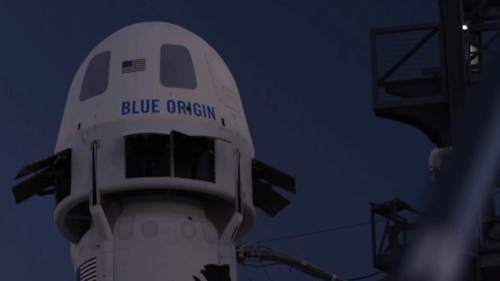
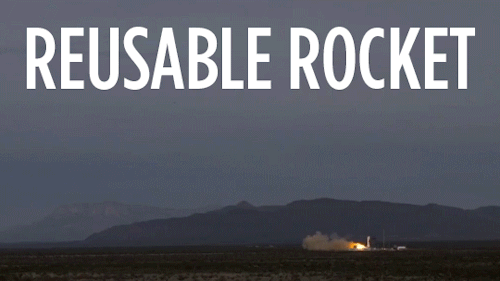

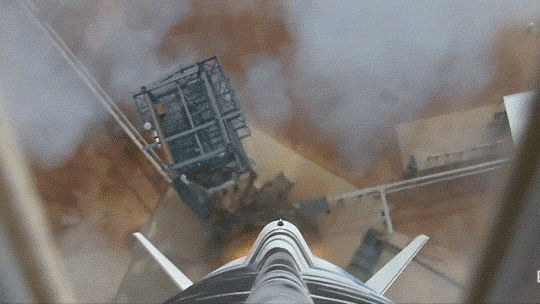
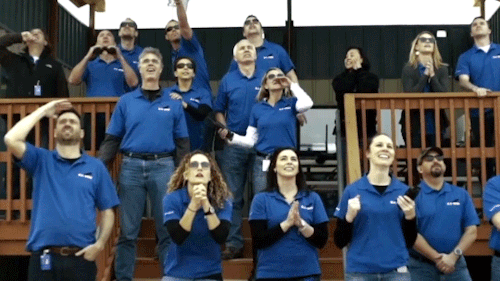
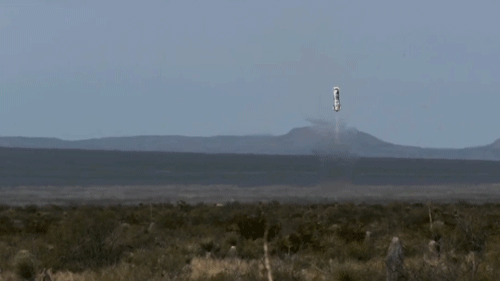

Via his very first tweet, Jeff Bezos announced that his spaceflight company has accomplished a historic first. It sent a rocket to the edge of space and then landed that rocket’s main fuselage gently on dry land.
Most things humans have sent into space are pushed up there by a disposable rocket. Once the rockets do their job, they fall back to earth, usually worse for wear. They have to be rebuilt each time (though sometimes their parts can be reused). That’s an expensive process, especially if you are a private company hoping to bring tourists to space. Virgin Atlantic, Elon Musk’s company SpaceX and Bezos’ Blue Origin all want to do just that.
And now Blue Origin has paved the way, landing its rocket on its second attempt (the propulsion module was destroyed when they first tried). Here’s the video in full:
Elon Musk responded to the news on Twitter. He pointed out that it requires much greater speed to actually reach orbit than it does to reach the edge of space. (Phil Plait has some good analysis of the exchange over on his Bad Astronomy blog.)
Still, it’s a pretty amazing accomplishment.
10 Intriguing Worlds Beyond Our Solar System
In celebration of the 20th anniversary of the first confirmed planet around a sun-like star (aka exoplanet), a collection of some interesting exoplanets has been put together. Some of these are rocky, some are gaseous and some are very, very cold. But there’s one thing each these strange new worlds have in common: All have advanced scientific understanding of our place in the cosmos. Check out these 10 exoplanets, along with artist’s concepts depicting what they might look like. For an extended list of 20 exoplanets, go HERE.
1. Kepler-186f

Kepler-186f was the first rocky planet to be found within the habitable zone – the region around the host star where the temperature is right for liquid water. This planet is also very close in size to Earth. Even though we may not find out what’s going on at the surface of this planet anytime soon, it’s a strong reminder of why new technologies are being developed that will enable scientists to get a closer look at distance worlds.
More Info
2. HD 209458 b (nickname “Osiris”)

The first planet to be seen in transit (crossing its star) and the first planet to have it light directly detected. The HD 209458 b transit discovery showed that transit observations were feasible and opened up an entire new realm of exoplanet characterization.
More info
3. Kepler-11 system

This was the first compact solar system discovered by Kepler, and it revealed that a system can be tightly packed, with at least five planets within the orbit of Mercury, and still be stable. It touched off a whole new look into planet formation ideas and suggested that multiple small planet systems, like ours, may be common.
More info
4. Kepler-16b

A real-life “Tatooine,” this planet was Kepler’s first discovery of a planet that orbits two stars – what is known as a circumbinary planet.
More info
5. 51 Pegasi b

This giant planet, which is about half the mass of Jupiter and orbits its star every four days, was the first confirmed exoplanet around a sun-like star, a discovery that launched a whole new field of exploration.
More info
6. CoRoT 7b

The first super-Earth identified as a rocky exoplanet, this planet proved that worlds like the Earth were indeed possible and that the search for potentially habitable worlds (rocky planets in the habitable zone) might be fruitful.
More info
7. Kepler-22b

A planet in the habitable zone and a possible water-world planet unlike any seen in our solar system.
More info
8. Kepler-10b

Kepler’s first rocky planet discovery is a scorched, Earth-size world that scientists believe may have a lava ocean on its surface.
More info
9. Kepler-444 system

The oldest known planetary system has five terrestrial-sized planets, all in orbital resonance. This weird group showed that solar systems have formed and lived in our galaxy for nearly its entire existence.
More info
10. 55 Cancri e

Sauna anyone? 55 Cancri e is a toasty world that rushes around its star every 18 hours. It orbits so closely – about 25 times closer than Mercury is to our sun – that it is tidally locked with one face forever blistering under the heat of its sun. The planet is proposed to have a rocky core surrounded by a layer of water in a “supercritical” state, where it is both liquid and gas, and then the whole planet is thought to be topped by a blanket of steam.
More info




mark your calendars!!!
Solar System: Top 5 Things to Know This Week
1. A Ceres of Fortunate Events

Our Dawn mission continues its exploration at Ceres, and the team is working with the data coming back to Earth, looking for explanations for the tiny world’s strange features. Follow Dawn’s expedition HERE.
2. Icy Moon Rendezvous
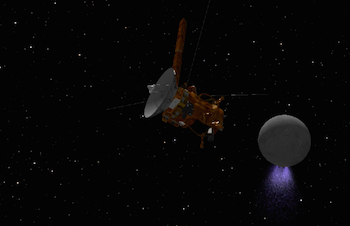
One of the most interesting places in the entire solar system is Saturn’s moon Enceladus, with its underground ocean and spectacular geyser plume. This month, the Cassini spacecraft will be buzzing close by Enceladus several times, the last such encounters of the mission. On October 14, Cassini will perform a targeted flyby at a distance of just 1,142 miles (1,838 kilometers) over the moon’s northern latitudes. Ride along with Cassini HERE.
3. Make Your Own Mars Walkabout
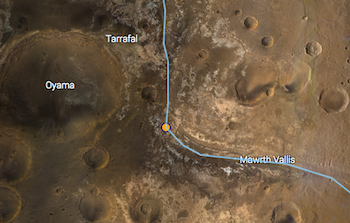
You can retrace Opportunity’s journey, see where the Curiosity rover is now, or even follow along with fictional astronaut Mark Watney from The Martian movie using the free online app MarsTrek. The app lets you zoom in on almost any part of the planet and see images obtained by our spacecraft, so you can plan your on Red Planet excursion. Take a hike HERE.
4. Elusive Features on Jupiter

New imagery from our Hubble Space Telescope is capturing details never before seen on Jupiter. High-resolution maps and spinning globes, rendered in the 4K Ultra HD format, reveal an elusive wave and changes to Jupiter’s Great Red Spot. Explore Jupiter HERE.
5. Mr. Blue Sky

Another week, another amazing picture from Pluto. The first color images of Pluto’s atmospheric hazes, returned by our New Horizons spacecraft last week, reveal that the hazes are blue. Who would have expected a blue sky in the Kuiper Belt? Most of the data collected during July’s Pluto flyby remains aboard the spacecraft, but the team publishes new batches of pictures and other findings on a weekly basis. Keep up with the latest HERE.
Make sure to follow us on Tumblr for your regular dose of space: http://nasa.tumblr.com
Alpha Centauri bb, an Earth-like planet orbiting our closest star, has just vanished. In fact, a new study suggests it never actually existed outside of a blip in the data.
The planet was discovered in 2012, and it was a pretty big deal at the time. According to researchers’ best estimates, Alpha Centauri bb appeared to have a mass similar to Earth and was orbiting its star at a distance similar to Mercury.
Best of all, it was only 4.3 light-years away – a whole lot closer than most other Earth-like exoplanets – and existed in a star system that had housed the science-fiction characters of Avatar and Transformers.
But a year after its discovery, a separate group of researchers called the discovery into question, when they found only weak evidence that the planet existed. And now a new study suggests that Alpha Centauri bb was never more than a ‘ghost’ in the data.
The research serves as a cautionary tale to astrophysicists hunting for evidence of planets orbiting distant stars, and reminds us of how hard it is to work out what’s going on using sporadic data taken from distant star systems.
Continue Reading.



clouds on mars, photographed by mars express, 16th january 2014.
around 43°s 258°e, one the eastern icaria planum. details from a sequence of 5 monochrome images, colourized with a bit of art and a bit of science.
image credit: esa. animation & colourization: ageofdestruction.
Hiro:... Hey tadashi.
Tadashi: yeah?
Hiro: is that a mirror in your pants?
Tadashi: what?
Hiro: cause i can see me in 'em.
Tadashi:...
Tadashi:...
Hiro: well?
Tadashi:... Get out.
abusive parents can buy their children nice things
abusive parents can provide food, shelter and other necessaries
abusive parents can be nice to their children at times
abusive parents can seem like the most loving parents in the world
You don’t know what goes on behind closed doors.

-
 mizukiyouko liked this · 5 years ago
mizukiyouko liked this · 5 years ago -
 mysteryspot liked this · 6 years ago
mysteryspot liked this · 6 years ago -
 allbirb liked this · 7 years ago
allbirb liked this · 7 years ago -
 ao3feed-newtina liked this · 8 years ago
ao3feed-newtina liked this · 8 years ago -
 melbahenry liked this · 8 years ago
melbahenry liked this · 8 years ago -
 aziz1universe-blog liked this · 8 years ago
aziz1universe-blog liked this · 8 years ago -
 nancynayeli98 reblogged this · 8 years ago
nancynayeli98 reblogged this · 8 years ago -
 infinite--cosmos-blog liked this · 8 years ago
infinite--cosmos-blog liked this · 8 years ago -
 profoundlydecaffeinatedgalaxy liked this · 8 years ago
profoundlydecaffeinatedgalaxy liked this · 8 years ago -
 jayne7030 liked this · 8 years ago
jayne7030 liked this · 8 years ago -
 dritantus liked this · 8 years ago
dritantus liked this · 8 years ago -
 pnwganja-blog liked this · 9 years ago
pnwganja-blog liked this · 9 years ago -
 nixnax liked this · 9 years ago
nixnax liked this · 9 years ago -
 reddon69 liked this · 9 years ago
reddon69 liked this · 9 years ago -
 allisonkitten reblogged this · 9 years ago
allisonkitten reblogged this · 9 years ago -
 joeyskyline liked this · 9 years ago
joeyskyline liked this · 9 years ago -
 skatan69 liked this · 9 years ago
skatan69 liked this · 9 years ago -
 natouuloves liked this · 9 years ago
natouuloves liked this · 9 years ago -
 saxophonium-blog1 liked this · 9 years ago
saxophonium-blog1 liked this · 9 years ago -
 ramenfightingpanda liked this · 9 years ago
ramenfightingpanda liked this · 9 years ago -
 ima-nature-person liked this · 9 years ago
ima-nature-person liked this · 9 years ago -
 1wildman98 liked this · 9 years ago
1wildman98 liked this · 9 years ago -
 jaimeroman liked this · 9 years ago
jaimeroman liked this · 9 years ago -
 casualnightmarekitty liked this · 9 years ago
casualnightmarekitty liked this · 9 years ago -
 telikos liked this · 9 years ago
telikos liked this · 9 years ago -
 freshsteel liked this · 9 years ago
freshsteel liked this · 9 years ago -
 sad-giirl liked this · 9 years ago
sad-giirl liked this · 9 years ago -
 deereidre liked this · 9 years ago
deereidre liked this · 9 years ago -
 lepetitemerde-blog reblogged this · 9 years ago
lepetitemerde-blog reblogged this · 9 years ago -
 alyssalenko reblogged this · 9 years ago
alyssalenko reblogged this · 9 years ago -
 alyssalenko liked this · 9 years ago
alyssalenko liked this · 9 years ago -
 prince-pietro liked this · 9 years ago
prince-pietro liked this · 9 years ago -
 serrilee liked this · 9 years ago
serrilee liked this · 9 years ago -
 hex-romancer liked this · 9 years ago
hex-romancer liked this · 9 years ago -
 terrenis liked this · 9 years ago
terrenis liked this · 9 years ago -
 catgirlconspiracy reblogged this · 9 years ago
catgirlconspiracy reblogged this · 9 years ago
"I don't know who will read this. I guess someone will find it eventually. Maybe in a hundred years or so." -Mark Watney
174 posts

